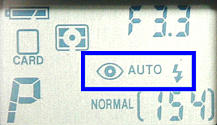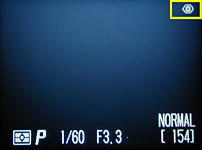 |
 |
| Red-Eye effect | |
What is the red-eye effect? The following is an example:
 |
 |
| Red-Eye effect | |
Red-eye is caused by light reflected off the subject's retina, and, as a result, a trace of red appears in the eyes of your subject. If the angle of reflection is less than 2.5 degree, red eye will occur. See the figure below. One way to overcome the red-eye effect is to move closer to your subject so that the angle of reflection is larger than 2.5 degree.

Or, you can use the internal red-eye reduction capability, although it may not be very effective.
To activate red-eye reduction in both A-REC and M-REC, use the flash setting button on the back panel:

Press this button until the eye icon appears on both the LCD panel and the LCD monitor as shown below. Once the eye icon appears, all subsequent shots using flash will use red-eye reduction.

|

|
| Control Panel | LCD monitor |
When red-eye reduction is in effect, do not move the camera immediately after the shutter release button is pressed to take a photograph. The camera will fire a red-eye reduction light for about one second, and then fire the flash to actually take the photograph you want. Therefore, after pressing the shutter release button, hold the camera steady for more than one second until the internal flash fires. Note that even with this red-eye reduction capability activated, the red-eye effect may not be gone completely. This situation could even be worse when you take photographs of your pets, especially your cats. The best way is to recompose so that the flash is not point directly to your subject's eyes. Or, consider the use of an external flash.

To eliminate red-eye, a has to be greater than 2.5 degree. Since tan(2.5 degree) = 0.04, X = 40cm. Since X is inversely proportional to a, to achieve a > 2.5 degree X < 40cm! In other words, the distance between the eyes of your subject and your camera must be less than 40cm. Forty centimeters is too short for a shoulder shot! Moreover, you perhaps do not want to ruin your subject's eyes! This is why 990's red-eye reduction is so ineffective.